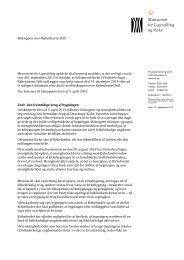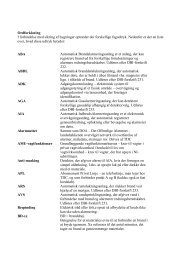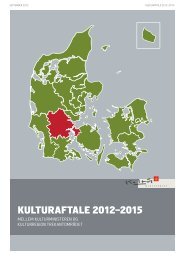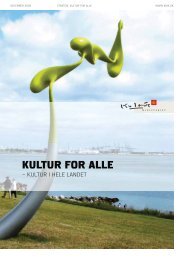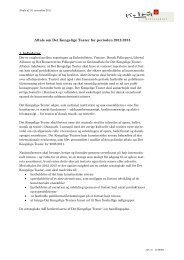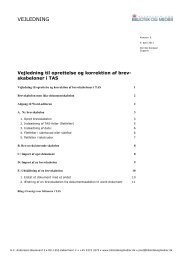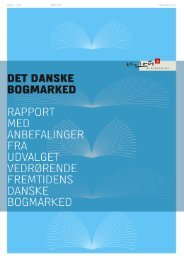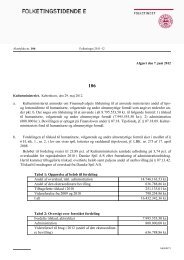Rock Festival Safety Table of contents
Rock Festival Safety Table of contents
Rock Festival Safety Table of contents
You also want an ePaper? Increase the reach of your titles
YUMPU automatically turns print PDFs into web optimized ePapers that Google loves.
to hostility and movements among the crowd. Movements that confirm the necessity to accommodate variance and<br />
strengthen community.<br />
The intensity <strong>of</strong> a concert’s or a festival’s bodily behaviour can vary considerably, depending, for instance, on the<br />
music, crowd composition and time <strong>of</strong> day. Among performers who overly stress close bodily activities, a high degree<br />
<strong>of</strong> intensity and dynamic can arise among the crowd, especially because this may be exactly what the fans want to<br />
experience or demand from the performer in question. Combined, these interests and types <strong>of</strong> behaviour create a<br />
physical intensity and dynamic that plays a central role for a large section <strong>of</strong> the crowd at a concert or festival. The<br />
opportunity to experience that one is up close. The individual is right in the middle <strong>of</strong> things. Things are really<br />
happening. There is, however, an issue <strong>of</strong> collective force, which can become so strong that it poses a threat to the<br />
public. Youth cult-<br />
ure thus displays not only social and bodily solidarity that can function as a haven, it also opens up for potential selfdestructive<br />
elements. A sense <strong>of</strong> tension which must always be kept in mind with respect to rock concerts and festivals.<br />
The crowd, the performers and the promoters must be prepared therefore for both anticipated and unanticipated<br />
behaviour and be equipped to regulate, call a halt to or ban behaviour that could constitute a wanton risk to everyone<br />
present.<br />
A HISTORICAL PERSPECTIVE<br />
The Christina Nilsson accident, 1885<br />
The world famous Swedish soprano, Christina Nilsson, was at pains to please a large, spontaneous crowd during a tour<br />
<strong>of</strong> her home country by singing from her balcony at the Grand Hotel in Stockholm, following her scheduled<br />
performance at the Academy <strong>of</strong> Music. The scene was repeated many evenings in succession and the crowd grew larger<br />
on each occasion. On 23 September 1885, ap-proximately 50,000 people had assembled in front <strong>of</strong> the hotel to listen to<br />
Christina Nilsson, equivalent to a quarter <strong>of</strong> Stockholm’s inhabitants, at the time. Having accepted the acclaim and<br />
ovation <strong>of</strong> the crowd, the singer encouraged the assembled to disperse. How-ever, a sense <strong>of</strong> panic gripped the crowd,<br />
apparently because its movement knocked over or destroyed the street lighting. People tried with all their might to<br />
escape from the scene. Many fell over piles <strong>of</strong> cobble stones outside a nearby building site and were trampled, one over<br />
the other. The 200-man strong police contingent on duty failed to bring the situation under control. The result was<br />
eighteen people dead and thirty injured.<br />
The Muslim Pilgrimage to Mecca<br />
At the Islamic pilgrimages to the holy cities <strong>of</strong> Mecca and Medina in Saudi-Arabia, where at any one time up to 2.5<br />
million people can be assembled, several accidents in which pilgrims have been trampled to death have occurred. One<br />
<strong>of</strong> the most serious incidents took place on 2 July 1990, when 1,426 pilgrims were trampled to death in an over<br />
congested<br />
pedestrian tunnel. Since then, pilgrimages in 1994 and 1998 reported 250 and 442 fatalities, respectively, in connection<br />
with mass demonstrations <strong>of</strong> the traditional and symbolic stoning <strong>of</strong> the devil.<br />
Sporting Events<br />
From 1980 to 1995, nine serious accidents were registered globally at sporting events, with over 400 dead and 3,000<br />
injured. The cause <strong>of</strong> these accidents can be classified in two groups:<br />
• Panic as a result <strong>of</strong> overcrowding in the stands<br />
• The outbreak <strong>of</strong> fire or collapse <strong>of</strong> stands<br />
None <strong>of</strong> these accidents happened in the Scandinavian area. However, subsequent to an incident at Vejle Stadium,<br />
Denmark, in 1995, the Ministry <strong>of</strong> Culture set up a working group whose remit was to examine safety at Danish sports<br />
centres/grounds. In Vejle a group <strong>of</strong> spectators were pushed out over the spectators enclosure and fell three metres to<br />
the ground, resulting in several minor and a few severe injuries.<br />
The WHO accident in Cincinnati, USA, 1979<br />
On 3 December 1979, 11 young people were killed and as many seriously injured when queuing for a WHO concert at<br />
Cincinnati’s Riverfront Colliseum. The exact circumstances surrounding the tragedy have never been fully clarified.<br />
The event, however, became a landmark in the sense that the accident was the occasion <strong>of</strong> an investigation that<br />
constituted the tentative beginning to what are today internationally recognised recommendations and strategies with<br />
respect to crowd management.<br />
The Castle Donnington accident in the UK, 1988<br />
During the course <strong>of</strong> a large open-air rock festival in Castle Donnington, UK, in 1988, at which many <strong>of</strong> the leading<br />
hard rock and heavy metal groups in the world at the time performed, two young men were crushed to death as a result<br />
<strong>of</strong> a pile up <strong>of</strong> fans in front <strong>of</strong> the stage. The accident, which occurred on 8 August 1988 during a Guns ‘n Roses<br />
concert, occa-<br />
sioned commencement <strong>of</strong> work on the first<br />
edition <strong>of</strong> The Event <strong>Safety</strong> Guide, referred to below, on the initiative <strong>of</strong> the British Home Office.<br />
The accident in Minsk, Belarus, 1999<br />
9



